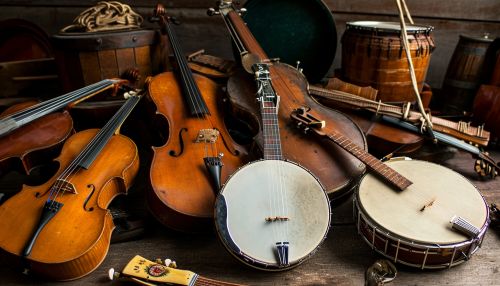Contemporary folk music
Origins and Evolution
Contemporary folk music, often referred to as "neo-folk", is a genre that emerged in the mid-20th century, drawing on traditional folk music traditions while incorporating elements of rock, pop, and other modern musical styles. The genre is characterized by its emphasis on acoustic instrumentation, often including guitar, banjo, and violin, and its lyrical themes, which often reflect social and political commentary, personal experience, and a connection to nature and place.


The roots of contemporary folk music can be traced back to the folk revival movement of the 1940s and 1950s in the United States and the United Kingdom. During this time, artists such as Woody Guthrie and Pete Seeger began to popularize traditional folk songs, often adding their own lyrical commentary on social and political issues of the day. This movement laid the groundwork for the emergence of contemporary folk music in the following decades.
Key Characteristics
Contemporary folk music is defined by a number of key characteristics. These include the use of acoustic instruments, a focus on melody and lyrics, and a connection to traditional folk music styles. The genre is also known for its diversity, with artists drawing on a wide range of influences and incorporating elements of various other musical styles.
One of the defining features of contemporary folk music is its emphasis on lyrics. Many contemporary folk songs are narrative in nature, telling stories or conveying messages through their lyrics. These songs often reflect the personal experiences and viewpoints of the artists, and may address themes such as love, loss, social justice, and environmentalism.
Another key characteristic of contemporary folk music is its use of acoustic instruments. While electric instruments and electronic production techniques are sometimes used, the genre is primarily defined by its use of traditional folk instruments such as the guitar, banjo, and violin. These instruments are often played in a simple, straightforward manner, with a focus on melody and harmony.
Influences and Subgenres
Contemporary folk music is a diverse genre, with artists drawing on a wide range of influences and incorporating elements of various other musical styles. This has led to the emergence of a number of subgenres, each with its own distinct characteristics.
One of the most significant influences on contemporary folk music is traditional folk music. Many contemporary folk artists draw on the musical traditions of their own regions or countries, incorporating traditional melodies, rhythms, and instruments into their music. This connection to tradition is often reflected in the lyrical themes of contemporary folk music, with many songs addressing issues of identity, heritage, and place.
In addition to traditional folk music, contemporary folk has been influenced by a variety of other musical genres. These include rock, pop, country, blues, and world music. These influences can be seen in the use of electric instruments, the incorporation of non-traditional song structures, and the exploration of new lyrical themes.
Notable Artists and Works
There are many artists who have made significant contributions to contemporary folk music. These include both established artists who have been active for decades, as well as newer artists who are pushing the boundaries of the genre.
One of the most influential contemporary folk artists is Bob Dylan. Dylan's music, which combines traditional folk melodies with poetic, often politically charged lyrics, has had a profound impact on the genre. His 1960s albums, including "The Freewheelin' Bob Dylan" and "The Times They Are a-Changin'", are considered classics of the genre.
Other notable contemporary folk artists include Joan Baez, Joni Mitchell, and Leonard Cohen, all of whom have made significant contributions to the genre. More recent artists, such as Mumford & Sons, The Lumineers, and Of Monsters and Men, have also had a significant impact on the genre, bringing contemporary folk music to a wider audience.
Contemporary Folk Music Today
Today, contemporary folk music continues to evolve, with artists pushing the boundaries of the genre and exploring new musical territory. The genre remains popular, with a vibrant community of artists and fans around the world.
Contemporary folk music is often associated with the indie music scene, with many artists releasing their music independently or on small, independent labels. The genre is also closely connected to the live music scene, with many artists performing at music festivals, folk clubs, and other live music venues.
While the genre remains rooted in traditional folk music, contemporary folk artists continue to incorporate elements of other musical styles, reflecting the diverse influences and creative approaches that define the genre. As a result, contemporary folk music remains a dynamic and evolving genre, offering a rich tapestry of sounds and stories for listeners to explore.
